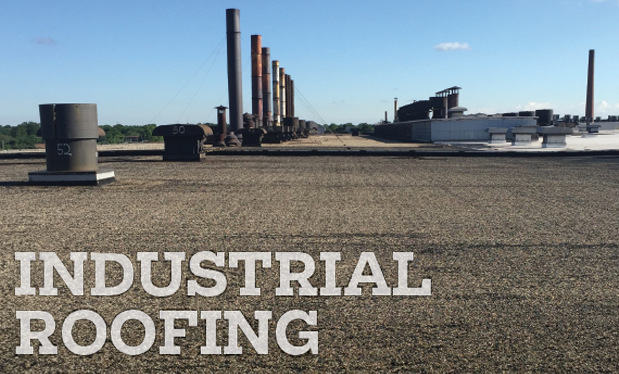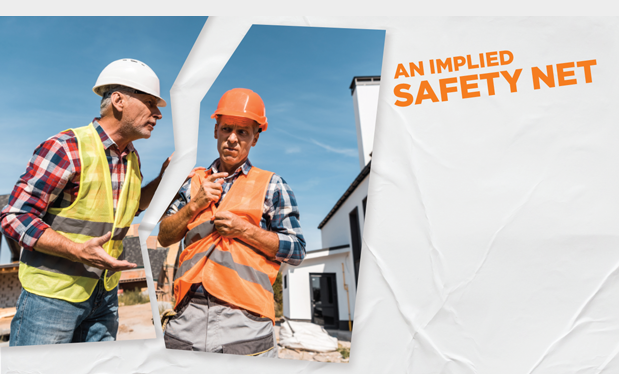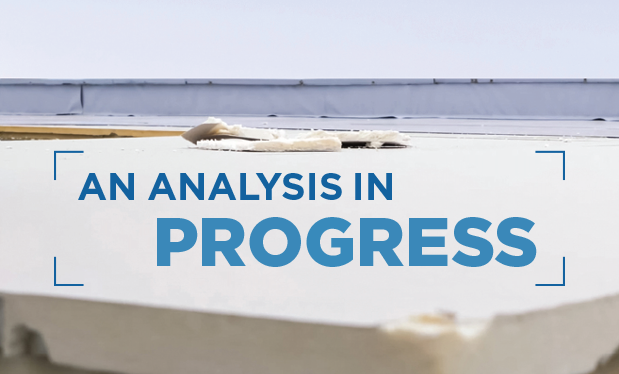In November 2019, the Steel Deck Institute issued new guidance for steel roof decks that features seam-fastened, mechanically attached, single-ply membranes. Although this guidance is directed toward roof deck designers, single-ply membrane manufacturers and suppliers, roof system designers and roofing contractors also should be aware of SDI’s latest guidelines.
Previous guidance
In May 2009, SDI issued a position statement, “Attachment of Roofing Membranes to Steel Deck,” indicating seam-fastened, mechanically attached, single-ply membrane roof systems apply wind-uplift loads to roof decks differently than adhered membrane roof systems. Although adhered membrane roof systems apply uplift loads uniformly across a roof deck, seam-fastened membrane systems result in concentrated line loads along the deck. Such line loads can result in excess bending moment and shear applied to the deck or a doubling of uplift loads on specific structural supports (joists) depending on the orientation of the membrane sheets relative to the deck flutes and joists.
SDI’s document goes on to recommend structural engineers should review the adequacy of steel roof decks and their underlying structural supports for their ability to resist design wind-uplift loads attributable to line loading from seam-fastened membrane systems. However, guidance to structural engineers regarding how to conduct such a review is not provided.
In January 2016 (and revised in April 2016), FM Global updated its Property Loss Prevention Data Sheet 1-29, “Roof Deck Securement and Above-Deck Roof Components,” to address concentrated line-load situations. FM 1-29 provides separate uplift design tables for steel roof decks in uniformly distributed and concentrated line-load conditions. Also, an additional table is provided for 60-ksi or greater yield strength steel roof decks; FM 1-29’s primary tables are based upon 33-ksi yield strength steel roof decks.
FM 1-29 indicates concentrated line-load conditions apply when the distance between rows of roof membrane fasteners is more than half the steel roof deck’s span.
SDI’s latest guidance
SDI’s new guidance is provided in its Technical Note—No. 7, “Mechanical Attachment of Single-Ply Roofing Membranes to Steel Roof Deck: Implications for Steel Deck Design.” This document indicates with seam-fastened, mechanically attached, single-ply membrane roof systems, though the membrane may have the performance characteristics to accommodate large-size tributary uplift loading, the concentrated line loads imposed on steel roof decks are different from those typically assumed in uniform load applications.
When rigid board insulation is attached to a steel roof deck with mechanical fasteners at a spacing of one per 4 square feet or less, any uplift load is assumed to be uniformly applied to the steel roof deck. Similarly with an adhered membrane roof system, the membrane is adhered to underlying insulation, which is attached to a steel roof deck in a uniform load manner.
With a seam-fastened membrane system, membrane seam fasteners apply wind-uplift loads to a steel roof deck as a series of line loads. In high wind and design wind load conditions, these concentrated line loads may exceed the uplift capacity of the steel roof deck and its connections to underlying supports.
SDI recommends steel decks and their attachments be designed using AISI S100-16, “North American Specification for the Design of Cold-Formed Steel Structural Members,” and ANSI/SDI RD-2017, “Standard for Steel Roof Deck.”
For seam-fastened, mechanically attached single-ply membrane roof systems, SDI considers the additional following guidelines to reflect generally accepted design practices:
- Analyzing the deck as a continuous three-span beam unless shorter spans are used
- Using all load combinations required by the applicable code
- For design spacing of fasteners lines, placing the first uplift line load at the midspan of the first deck span then continuing to add line loads based on membrane seam spacing
- For determining maximum uplift on deck securement fasteners and support framing, placing a line load atop a support
SDI also offers the following recommendations:
- For seam-fastened systems, SDI recommends a structural engineer review the adequacy of steel decks and structural supports. In reroofing situations, SDI recommends a “competent structural engineer” be engaged to determine any limitations imposed by an existing steel roof deck.
- Designers should specify or require preconstruction submittal of membrane sheet layouts to ensure lines of fasteners comply with the designer’s assumptions. Membrane seam attachment should only be perpendicular to the ribs of a steel roof deck; membrane seams should not be attached parallel to deck ribs.
SDI’s technical note includes six appendices providing useful design analysis examples. These examples also illustrate the magnitudes of the loading differences between uniformly distributed and concentrated line-load conditions.
Closing thoughts
Seam-fastened, mechanically attached, single-ply membrane systems present unique wind-uplift loading considerations.
Although the design of steel roof decks is beyond the expertise and responsibility of single-ply membrane manufacturers and suppliers, roofing contractors and most roof system designers, you should be aware, in general, of these considerations.
Mark S. Graham is NRCA's vice president of technical services.
@MarkGrahamNRCA
To read more about this topic, see “The situation with steel roof decks,” March 2017 issue.
This column is part of Research + Tech. Click here to read additional stories from this section.



